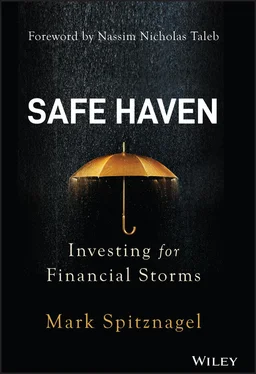Investing is a deceptive, uneven playing field for many reasons, and I aim to help level it out a little. (To show you the honor of my intentions, I pledge all of my proceeds from the sales of this book to charity.)
This book is the result of a discovery process and problem‐solving effort that began many years ago. I grew up a scrappy, poor kid in the Chicago commodities trading pits, back when they were the center of the financial universe. As a mere teenager, I learned from my mentor, Everett Klipp (“the Babe Ruth of the Chicago Board of Trade”), who told me over and over that “a small loss is a good loss,” and that risk mitigation and survival are everything in trading and investing. His words still ring true today: Take care of the losses; the profits will then take care of themselves. Profits matter only relative to the losses; stay in the game by protecting your capital base, your means of playing the game. Don't predict.
Pretty obvious stuff, except people don't really focus on losses, especially the potential for big ones. In all my experience, most investors don't think about the impact of the downside the way they need to; they just don't.
For me, it began with hands‐on, trial‐and‐error experiments in my twenties as a “local” (or independent) trader in the bond pit in Chicago. (I earned much of my stake in college by writing and then selling the first portfolio management handheld computer program on the trading floor.) It continued in my thirties as a bank proprietary and hedge fund derivatives trader in New York, and even a bit in the hallowed halls of New York University's Courant Institute of Mathematical Sciences. I hashed it out in endless discussion‐walks through the streets of Manhattan with Nassim Nicholas Taleb, in the days when we started the very first formal tail hedging program, and he would later become Scientific Advisor at Universa. These ideas were the point of every conversation during countless, reckless longboard skateboard cruises up and down the treacherous hills and dales of Central Park with Brandon Yarckin as we plotted the launch of Universa, where he would become COO. (I still blame Brandon for my separated shoulder.)
And it goes without saying that I have not made these observations from scratch. I owe an enormous gratitude to the explorers who plumbed the depths (“the triad”).
These were the formative years of probing bets, of bold conjectures and refutations, and finding answers to how things worked through success and failure—of a bloody war against luck. The conclusion was my decision to start Universa in 2007, where we have taken our discoveries and solutions and transformed them into a formal, rational, and practical investment approach that solves the big problems and moves the needle for my investment partners.
By opening this book and, I would hope, opening your mind to the ideas it contains, you will have the opportunity to change your perceptions about investing and risk mitigation. These pages will present a fundamentally different, unconventional perspective that I firmly believe is the most effective one for successful investing. It opposes so much of what is hailed as gospel within the collective that is the investment profession. So, we need to think objectively about the orthodoxy and dead‐end dogma of modern finance. We need to be the uncarved block.
To be sure, I have no interest in changing the existing investing paradigm by making it obsolete. I'm no pied piper, and I harbor no delusions of grandeur that the message of this book will ever become “the new gospel according to Mark.” I do not expect for one moment that my approach will ever become another cookie‐cutter, rubber‐stamped strategy of the investment consultant herd. And that's important. Becoming conventional is self‐defeating in this business. It's the kiss of death. We take the road less traveled by, and that has made all the difference.
I have often exclaimed to my team at Universa, plundering the words of Steve Jobs, “We are pirates! Not the Navy!” (Mine are the smartest, savviest, and most experienced Great Pirates in the derivatives world.)
Everyone has some intuitive understanding about what a safe haven is and why we would invest in one. Most likely, it would go something like “a place of refuge for when things go bad” or, more specifically, “an asset that provides safety from risk.” These are spot on. The term risk would likely mean scary things like stock market crashes, financial and banking crises, pandemics, monsters hiding under the bed, and so forth. Risk, then, is circularly defined as that equivocal thing we need safety from.
Plain and simple, risk is exposure to bad contingencies. Most of these bad contingencies will likely never happen, but they can happen. In investing, the bad contingencies have financial consequences of economic loss within a portfolio. Investment risk isn't just some theoretical and spurious numerical value, like volatility or correlation or whatever. It is the potential for loss, and the scope of that loss. Nothing else.
We have many diverging roads ahead, many potential paths forward with so many twists and turns, more than we can ever count. Some of those potential paths will be very pleasant, and some of those potential paths won't be. Of all the potential paths, we don't know which is the one and only path that we will actually traverse. Now, that's risk!
A safe haven is an investment that mitigates risk, or the bad potential economic contingencies in your investment portfolio. That is a necessary condition for safe haven status. It protects against consequential loss that happens to everyone, everywhere, all at the same time, because that loss is tied to the cycles of broad macroeconomic growth and contraction. Because of its ubiquitous and systematic nature, you can't just diversify that risk away with groupings of things that supposedly won't experience such loss simultaneously.
And remember this: A safe haven isn't so much a thing or an asset. It is a payoff , one that can take many different forms. It might be a chunk of metal, a stock selection criterion, a crypto‐currency, or even a derivatives portfolio. Whatever forms they may take, it is their function that makes safe havens what they are: They preserve and protect your capital. They are a shelter from financial storms.
So safe haven investing is risk mitigation . To me, these two terms are synonymous, and I will be using them interchangeably throughout this book. (The former made for a catchier title.)
What's more, risk mitigation is investing itself . Treat this as a fundamental premise. Even the most renowned proponent of the bottom‐up approach to investing, Benjamin Graham, the “father of value investing,” declared: “The essence of investment management is the management of risks, not the management of returns. Well‐managed portfolios start with this precept.” Moreover, “Confronted with a challenge to distil the secret of sound investment into three words, we venture the motto, Margin of Safety.” Truer words have never been written on the subject. For Graham, “safety of principal” is what separates investing from speculating. It makes investing—investing! (He learned the hard way, in the 1929 stock market crash, that all great ideas can be dashed, simultaneously and systematically.)
But this is the pretty obvious part. It still misses what's so special about what a safe haven should be. Any punter can devise something that does well in a financial crash. Safe haven investing is so much more. And this is where they start to look really different from each other—so different that our classification that would put them all in the same category starts to lose its meaning. Often, they are more different than they are alike. We run into issues similar to what biologists encountered when trying to define what a species is. We will need a specific safe haven concept —like their species concept —in order to classify them and evaluate if they are even what they claim to be. This will be a major line of inquiry in this book: Are safe havens a classifiable thing? And can they really add economic value?
Читать дальше












